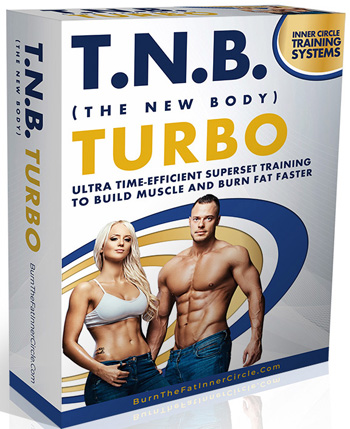Scientific studies say that superset training is so efficient, it can cut your gym time in half. That’s great for busy folks, but it also brings up the question: Are these “time efficient” workouts any good at building muscle and strength, or is there a huge compromise, like put in half the time and only get half the results?
 A recent study from Brazil answered this question – are supersets good for building muscle – and the results were a surprise, even to many scientists and expert trainers.
A recent study from Brazil answered this question – are supersets good for building muscle – and the results were a surprise, even to many scientists and expert trainers.
The researchers tested a special type of superset called an antagonist pair. In this case it was the bench press alternated with seated cable rows.
Another classic example of an antagonist superset is the the bicep curl follow by the tricep extension.
Specifically, they wanted to test the effect of doing two exercises in a row nonstop on “volume load” and muscle activation.
Volume load, which is also known as tonnage, is the number of reps times the weight (load). For example, if you bench 200 pounds for 10 reps and do 3 sets, the volume load is 200 X 10 X 3 = 6000 pounds for that exercise.
This is a good number to track, because if volume load is going up over time, it’s safe to predict that you’re going to gain muscle and strength (as long as you’re not messing up your nutrition and staying out partying all night).
If you try a new workout system that condenses your workout into half your usual time, but forces your volume load to drop, you would still get some benefits (it’s not like the workout was useless), but it would mean there’s a trade off: a gain in efficiency, but a loss in effectiveness, compared to good old straight sets.
No one debates the efficiency benefits of supersets – they’re a boon for the busy. But many people are skeptical about whether supersets are as good as traditional training, especially when claims are made like, “gain more muscle in less time.”
After all, “Cut your workout time” is one thing, but “Cut your gym time by half and get more effective workouts” is a pretty big deal.
Guess what? In this recent superset study, that’s exactly what happened. Volume load increased and so did muscle activation (measured with EMG).
How is this possible? Why isn’t there a big compromise in effectiveness when supersetting?
It appears that antagonist supersets have a special effect if they’re done in a certain way.
Here’s how antagonist paired set training was done: The bench press was done first. With little or no rest in between, a set of seated cable rowing was done second. That’s when the subjects got to take a rest – two minutes in this case. That was one superset.
They repeated this two more times for a total of three supersets (a grand total of six sets).
It’s obvious where the time savings come from: the rest interval between each pair of exercises was removed.
In this study, they didn’t do a whole body or even half body workout, but you get an idea of the potential time savings when you look at the results: The chest and back workout was 16 minutes long in the traditional set group and only 8.5 minutes long in the superset group.
Pretty awesome. But how specifically is it possible that muscle and strength gains weren’t compromised? Wouldn’t your muscles be so tired on that second exercise that your performance drops?
One answer is that these supersets worked opposite muscles, not the same muscle. That means while the back was working in the row, the chest was resting and recovering from the bench press.
Another theory is increased elastic energy storage. Yet another is that the golgi tendon organs adjust in some way after a pre-load.
Other scientists think the nervous system is stimulated differently with antagonist preloading. Additional motor units (muscle fibers) may be recruited or the muscle fibers may synchronize better or contract faster.
This area is open for more research to clarify the mechanisms and it gets more complicated than the average lifter needs to bother with. The main thing to know is that there’s something special going on when you train opposite muscles in alternating pairs and it maintains or improves your performance in the second exercise.
An important practical point is that the effectiveness of supersets appears to depend a lot on the length of the rest interval.
It may take a full two minutes between supersets to recover completely enough to see improvements like those in this study. If you don’t rest much after each superset because you’re hell-bent for ultimate time efficiency, that’s fine, but that’s also when you trade efficiency for performance.
If you take a long break between each pair of exercises, some of the benefits of the superset are lost. Therefore, you should move quickly from the first exercise to the second exercise and only then take your rest break before repeating the next superset.
In this study, the subjects kept their rest time down to 10 seconds, which was simply the time it took to move to the equipment for the next exercise.
If you ask the strongest bros in the gym, they’ll almost all tell you that long rest periods between sets improve strength and workout performance the most, and this is still the general rule today (especially in powerlifting and maximum strength training).
But antagonist supersets seem to be a special case. Basically, it’s not as effective a superset if you chill out and take your time between the two exercises (something to keep in mind if you superset on two different pieces of equipment in a crowded gym).
Last but not least…
If this antagonist pair superset method is so effective for building muscle, then that brings up another big question:
Why shouldn’t everyone train with antagonist supersets all time?
First of all, there are a limited number of superset pair combinations that use an exact reciprocal movement (same plane; opposite movement pattern or joint action). That limits the application of this technique a bit (though you can use any kind of superset you want for saving time).
Also, while it appears certain exercise combinations can increase strength and performance, or at least maintain them while cutting workout time, there’s not enough research on a wide enough variety of exercises in a variety of rep ranges to say for sure these results will hold true in all cases for all people.
We know that traditional sets with longer rest intervals are time-tested and proven effective in the real world when maximum strength is the goal.
When the goal is hypertrophy (muscle size), the answer is a bit more complex because there’s more than one mechanism of muscle growth. Still, the amount of weight lifted matters for bodybuilders too (it’s a major variable in the volume load equation), so it’s also premature to say that supersets are across the board superior for muscle size gains either.
There’s also the matter of personal preference and level of need for time efficiency. Many people are bored out of their minds resting two minutes between every set (let alone three to five, as some strength workouts prescribe). Superset training is faster-paced, more engaging and more enjoyable for many people, so it becomes their preference in training style.
That’s important because if you like your workouts, you’re more likely to stick with them.
Other people enjoy a more relaxed pace and have no time restrictions – they’d just as soon take a 70-minute workout, knowing they’re not in a hurry, they might get better strength gains, and they like it better, than feel rushed to get done in 35 minutes, with some doubt about whether that shorter workout is superior.
What we can conclude about supersets at this point is:
1. Superset training is a valuable tool for busy people to shorten their training time (supersets are efficient).
2. Everyone can expect superset workouts to produce great results (supersets are effective).
3. We can’t say say supersets are always more effective than straight sets (straight sets are effective too).
Given that the body adapts more quickly when presented with the same training stimulus all the time, we could also make an argument that it’s worth using both types of training – straight sets and supersets – so we can compare the results and gauge our enjoyment of the style, as well as continue “shocking” the body with different stimuli to prevent adaptation.
Not only could this training variety produce new gains, it could keep boredom away as well. So while there’s no reason everyone must use superset training if they’re not pressed for time, there’s every reason to give supersets a try or at least have it as another arrow in your quiver of training tactics for those occasions where life gets hectic and you need workouts that are both efficient and effective.
The workout done in this study was only a single superset for chest and back. You could go try that pair of exercises on your next upper body day, but if you want a complete Superset training routine for your entire body, check out my newest training program, TNB-TURBO.
Train hard and expect success,
Tom Venuto,
Author of: Burn The Fat Feed The Muscle
Creator of The New Body (TNB) Turbo
IS BUILDING MUSCLE IN LESS TIME YOUR #1 GOAL? If so, The New Body (TNB) TURBO is the program for you: Ultra-time efficient “superset” training proven by science to build muscle in 50% of the time. To learn more CLICK HERE
Scientific References:
Paz GA, et al, Volume load and neuromuscular fatigue during an acute bout of agonist-antagonist paired-set vs. traditional-set training, Journal of Strength And Conditioning Research, 31(10): 2777-2784, 2017. Federal University, Rio de Janeiro, Brazil.







Leave A Comment